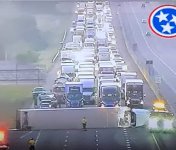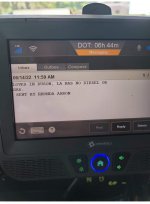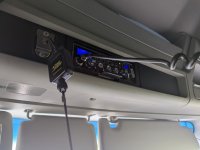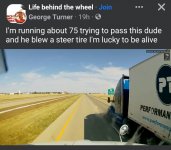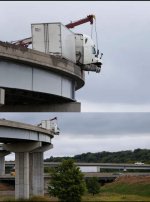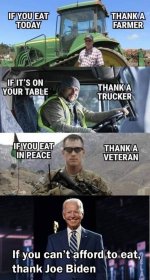You are using an out of date browser. It may not display this or other websites correctly.
You should upgrade or use an alternative browser.
You should upgrade or use an alternative browser.
Trucking!
- Thread starter ok doser
- Start date
I stop there every so often. It's a worthy place to visit.
I need to visit the museum at some point. It's the one thing I want to visit that I just haven't been able to yet.
Right Divider
Body part
I've stopped there are couple of times and passed by it hundreds of times. I live in Illinois, but am from Iowa originally.I stop there every so often. It's a worthy place to visit.
ok doser
lifeguard at the cement pond
Shaking up the industry

 www.freightwaves.com
www.freightwaves.com
FMCSA revising guidance on freight brokers and agents

FMCSA revising guidance on freight brokers and agents
The FMCSA is looking to the public to help settle a controversy over what constitutes freight brokers, agents and dispatch services.
 www.freightwaves.com
www.freightwaves.com
ok doser
lifeguard at the cement pond
Finally getting around to watching this and the first clip is from my dad's favorite movie, Dennis Weaver in Duel
Oh, Duel. What a great, unique movie. @JudgeRightly if you've never seen Duel, YouTube has the Spanish version but it doesn't matter because only a few words were spoken throughout the entire movie. Like I said, it's unique.Finally getting around to watching this and the first clip is from my dad's favorite movie, Dennis Weaver in Duel
Oh, Duel. What a great, unique movie. @JudgeRightly if you've never seen Duel, YouTube has the Spanish version but it doesn't matter because only a few words were spoken throughout the entire movie. Like I said, it's unique.
I'll probably watch it on Amazon Prime Video at some point. I've added it to my watchlist.
ok doser
lifeguard at the cement pond
Idolater
Popetard
Always just good to remember whenever you're near one of these things on the road, they are categorically dissimilar to whatever it is you happen to be driving in. When driving around them, I feel as apprehensive and alert as I do when handling a gun. Usually nothing's going to happen, but know what might happen, and work hard to make sure that if that happens, that nobody gets killed or goes to the hospital.
ok doser
lifeguard at the cement pond
Self-administered extremely late term abortion
 fb.watch
fb.watch
Discover Popular Videos | Facebook
Video is the place to enjoy videos and shows together. Watch the latest reels, discover original shows and catch up with your favorite creators.
 fb.watch
fb.watch
That trailer is the only thing keeping the truck from going over, due to leverage...
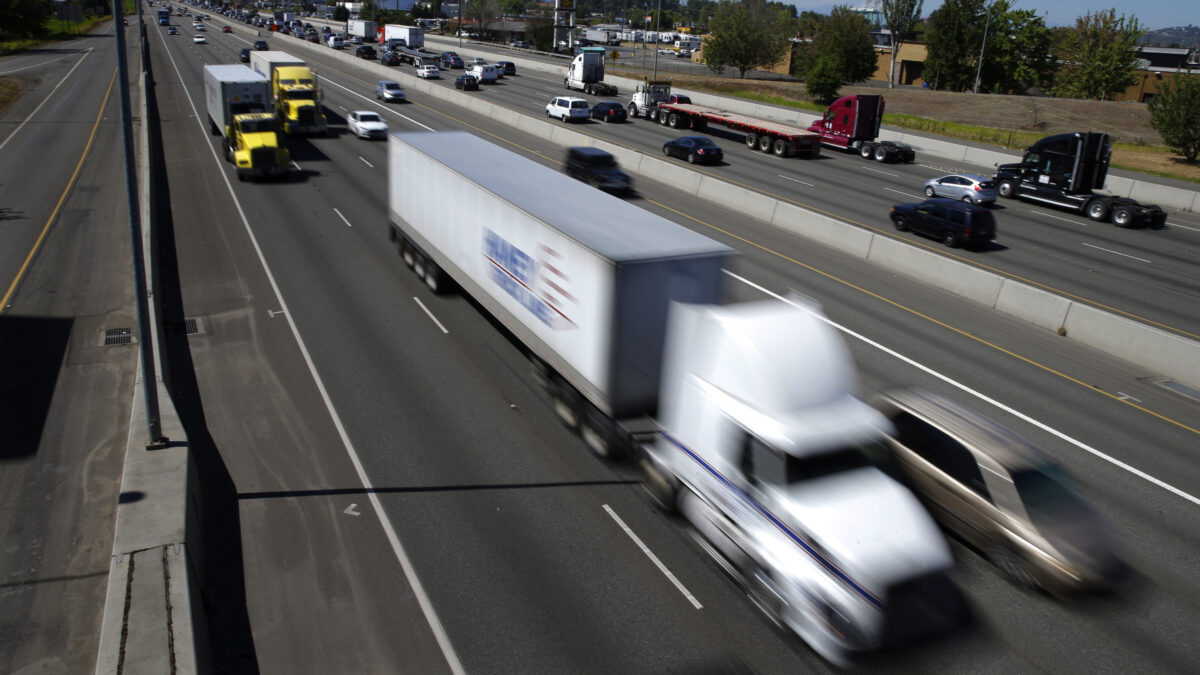
FMCSA’s speed limiters: Unsafe at any speed?
Public comments reveal most truckers believe a proposal to require engines to have speed limiters will make roads less safe.
 www.freightwaves.com
www.freightwaves.com
I'm personally against putting speed limiters on trucks, for the reasons outlined in this article.
ok doser
lifeguard at the cement pond
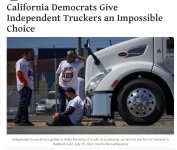
Comply with A.B. 5, or quit being a truck driver.
Until now in California, truck drivers have had a choice. They could be employees of trucking companies, or they could be independent owner-operators.
But in 2019, California decided it knew better. Governor Gavin Newsom signed A.B. 5, a law that sought to classify more workers as employees instead of independent contractors. California exempted many industries from the law, including parts of the state’s entertainment industry. In 2020, 59 percent of California voters approved a ballot initiative to exempt rideshare drivers from A.B. 5.
Despite truckers speaking out at the time, legislators ignored their requests for an exemption. The California Trucking Association went to the courts instead, arguing that A.B. 5 was a state law that affected “rates, routes, and services,” which is prohibited by federal law (trucking, being interstate, is a federally regulated industry). In 2020, the lower court agreed with that argument and stayed enforcement of the law against truckers.
The Ninth Circuit Court of Appeals disagreed, ruling against the CTA. While the CTA appealed to the Supreme Court, though, the lower court’s stay remained in effect. It wasn’t until this year that the Supreme Court decided it would not take the case. That means the Ninth Circuit’s ruling stands, which allowed A.B. 5 to go into effect against truckers.
That’s why a law passed in 2019 is leading to protests now. Truckers at the Port of Oakland blocked access to cargo terminals this week, causing massive delays and essentially bringing port activity to a halt. They directed their ire at Governor Newsom and said, “Cargo won’t flow until AB5 goes.”
Newsom deserves it. The progressive Democrats in California’s state government decided to push through A.B. 5, knowing full well the consequences it could have for trucking.
The owner-operator model is very common, and the American trucking industry is dominated by small businesses, not large nationwide firms. As the Owner-Operator Independent Drivers Association noted in its 2022 annual membership survey, federal DOT statistics show that 90 percent of all fleets operate ten or fewer trucks, and 50 percent of fleets are one-truck operations.
According to the survey, owner-operators are far more likely than members of the general public to have served in the military (32 percent report having served). The top reason owner-operators give for driving independent is the ability to be their own boss. The top challenge named by owner-operators was complying with government regulations.
In the past, it was more common for owner-operators to be sole proprietors, but now it’s more common for them to form LLCs to do business. Owner-operators either have direct relationships with shippers, or they go through freight brokers to get contracts. The median owner-operator made $190,000 in gross income with $118,000 in expenses in 2021, yielding a median net income of $72,000.
That’s decent money for a job that doesn’t require a college degree, and it’s especially lucrative for immigrants in California. A 2019 Los Angeles Times story said that nearly half of California truck drivers are immigrants. Most are from Mexico and Central America, but the share from India is increasing.
The Los Angeles Times article tells the story of Palwinder Singh, a Punjabi Sikh who immigrated to America in 2001. He was robbed at gunpoint after working the night shift at a convenience store, and took up trucking after that. He started out as an employee driver but eventually bought his own truck and started his own business. He works directly with shippers and his company had grown to a second truck, driven by his brother, the story says. He makes over $80,000 a year, which he uses to help support his wife, son, and extended family.
Drayage truckers operate short routes, running back and forth between a port and the various cargo facilities located near the port. With thousands of containers and countless businesses, drayage truckers have plenty of options to find deliveries. That’s likely why about 70 percent of California drayage truckers are owner-operators, more than the national average. Since they’re never too far from home, they can sleep in their own bed at night and be there for their families, unlike cross-country drivers who spend days and weeks on the road.
The Harbor Trucking Association, the trade association for West Coast drayage truckers, put out a statement opposing A.B. 5. CEO Matt Schrap said, “Bottom line, California has basically tossed these drivers and their dreams aside for the sake of political expediency in order to satisfy the wants and desires of special interests.”
Who benefits? Unions such as the Teamsters, who will now be able to recruit new members. Only employee drivers are eligible for unionization, and the large contingent of independent owner-operators has always irked organized labor.
What must be driving them even crazier is that the independent owner-operators are effectively making their voices heard without being unionized, capturing national media attention and bringing port activity to a standstill. Some unionized dockworkers sympathized with the non-union truck drivers, forcing dockworker-union leadership to put out a statement clarifying that the union supports A.B. 5.
Governor Newsom himself has yet to say a word about the protests, which are now entering their fifth day. A spokesman for Newsom’s office said yesterday that drivers “should focus on supporting this transition” and signaled that the governor does not plan to budge on allowing an exemption for trucking.
With supply chains already stressed and drivers already overworked, California Democrats have substituted the free choice of being an employee or an owner-operator with an impossible choice: Comply with A.B. 5, or quit being a truck driver.

California Democrats Give Independent Truckers an Impossible Choice |…
archived 24 Jul 2022 12:04:17 UTC
ok doser
lifeguard at the cement pond
One question that I haven't seen answered yet is how this will affect independents driving in and out of the state. I understand how it affects people driving within the state. But an awful lot of freight, especially produce, moves out of California to go all over the country, carried by independent owner operators. How will this bill affect the independent owner operator based in Florida, for example, who is hauling produce from San Diego to Minneapolis in the winter?View attachment 3976
Comply with A.B. 5, or quit being a truck driver.
Until now in California, truck drivers have had a choice. They could be employees of trucking companies, or they could be independent owner-operators.
But in 2019, California decided it knew better. Governor Gavin Newsom signed A.B. 5, a law that sought to classify more workers as employees instead of independent contractors. California exempted many industries from the law, including parts of the state’s entertainment industry. In 2020, 59 percent of California voters approved a ballot initiative to exempt rideshare drivers from A.B. 5.
Despite truckers speaking out at the time, legislators ignored their requests for an exemption. The California Trucking Association went to the courts instead, arguing that A.B. 5 was a state law that affected “rates, routes, and services,” which is prohibited by federal law (trucking, being interstate, is a federally regulated industry). In 2020, the lower court agreed with that argument and stayed enforcement of the law against truckers.
The Ninth Circuit Court of Appeals disagreed, ruling against the CTA. While the CTA appealed to the Supreme Court, though, the lower court’s stay remained in effect. It wasn’t until this year that the Supreme Court decided it would not take the case. That means the Ninth Circuit’s ruling stands, which allowed A.B. 5 to go into effect against truckers.
That’s why a law passed in 2019 is leading to protests now. Truckers at the Port of Oakland blocked access to cargo terminals this week, causing massive delays and essentially bringing port activity to a halt. They directed their ire at Governor Newsom and said, “Cargo won’t flow until AB5 goes.”
Newsom deserves it. The progressive Democrats in California’s state government decided to push through A.B. 5, knowing full well the consequences it could have for trucking.
The owner-operator model is very common, and the American trucking industry is dominated by small businesses, not large nationwide firms. As the Owner-Operator Independent Drivers Association noted in its 2022 annual membership survey, federal DOT statistics show that 90 percent of all fleets operate ten or fewer trucks, and 50 percent of fleets are one-truck operations.
According to the survey, owner-operators are far more likely than members of the general public to have served in the military (32 percent report having served). The top reason owner-operators give for driving independent is the ability to be their own boss. The top challenge named by owner-operators was complying with government regulations.
In the past, it was more common for owner-operators to be sole proprietors, but now it’s more common for them to form LLCs to do business. Owner-operators either have direct relationships with shippers, or they go through freight brokers to get contracts. The median owner-operator made $190,000 in gross income with $118,000 in expenses in 2021, yielding a median net income of $72,000.
That’s decent money for a job that doesn’t require a college degree, and it’s especially lucrative for immigrants in California. A 2019 Los Angeles Times story said that nearly half of California truck drivers are immigrants. Most are from Mexico and Central America, but the share from India is increasing.
The Los Angeles Times article tells the story of Palwinder Singh, a Punjabi Sikh who immigrated to America in 2001. He was robbed at gunpoint after working the night shift at a convenience store, and took up trucking after that. He started out as an employee driver but eventually bought his own truck and started his own business. He works directly with shippers and his company had grown to a second truck, driven by his brother, the story says. He makes over $80,000 a year, which he uses to help support his wife, son, and extended family.
Drayage truckers operate short routes, running back and forth between a port and the various cargo facilities located near the port. With thousands of containers and countless businesses, drayage truckers have plenty of options to find deliveries. That’s likely why about 70 percent of California drayage truckers are owner-operators, more than the national average. Since they’re never too far from home, they can sleep in their own bed at night and be there for their families, unlike cross-country drivers who spend days and weeks on the road.
The Harbor Trucking Association, the trade association for West Coast drayage truckers, put out a statement opposing A.B. 5. CEO Matt Schrap said, “Bottom line, California has basically tossed these drivers and their dreams aside for the sake of political expediency in order to satisfy the wants and desires of special interests.”
Who benefits? Unions such as the Teamsters, who will now be able to recruit new members. Only employee drivers are eligible for unionization, and the large contingent of independent owner-operators has always irked organized labor.
What must be driving them even crazier is that the independent owner-operators are effectively making their voices heard without being unionized, capturing national media attention and bringing port activity to a standstill. Some unionized dockworkers sympathized with the non-union truck drivers, forcing dockworker-union leadership to put out a statement clarifying that the union supports A.B. 5.
Governor Newsom himself has yet to say a word about the protests, which are now entering their fifth day. A spokesman for Newsom’s office said yesterday that drivers “should focus on supporting this transition” and signaled that the governor does not plan to budge on allowing an exemption for trucking.
With supply chains already stressed and drivers already overworked, California Democrats have substituted the free choice of being an employee or an owner-operator with an impossible choice: Comply with A.B. 5, or quit being a truck driver.

California Democrats Give Independent Truckers an Impossible Choice |…
archived 24 Jul 2022 12:04:17 UTCarchive.ph

